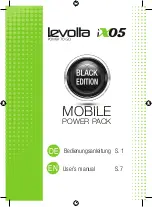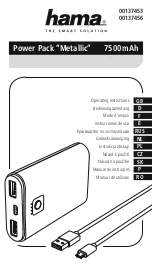
ASSEMBLY
ALWAYS TURN OFF THE TOOL BEFORE
CHANGING ACCESSORIES, CHANGING
COLLETS, OR SERVICING THE TOOL.
IMPORTANT CHARGING NOTES
1. The charger was designed to fast charge the
battery only when the battery temperature
is between 32°F )0°C( and 113°F )45°C(. If
the battery pack is too hot or too cold, the
charger will not fast charge the battery. )This
may happen if the battery pack is hot from
heavy use). When the battery temperature
returns to between 32°F )0°C( and 113°F
)45°C(, the charger will automatically begin
charging.
2. A substantial drop in operating time per
charge may mean that the battery pack is
nearing the end of its life and should be
replaced.
3. Remember to unplug charger during storage
period.
4. If tool does not charge properly:
a. Check for voltage at outlet by plugging in
some other electrical device.
b. Check to see if outlet is connected to a
light switch which turns power “off” when
lights are turned off.
c. Check charging base and power supply
terminals for dirt. Clean with cotton swab
and alcohol if necessary.
d. If you still do not get proper charging,
take or send tool to your local Dremel
Service Center.
NOTE: Use of chargers or battery packs not sold
by Dremel will void the warranty.
CHARGING BATTERY PACK
FUEL GAUGE
This tool is equipped with a fuel gauge that tells
you how much charge your battery has. A fully
charged battery is indicated when the light is
green. As the battery discharges, the light will
turn orange. When the light is red, the battery is
almost empty. When the battery is dead, the tool
will automatically turn off. This will be a sudden
stop as opposed to a gradual winding down of the
tool. Simply recharge the tool and reuse.
Green Light - 100% charge remaining.
Orange Light – 50% charge remaining or the tool
is being used in heavy applications )low battery
voltage due to current draw).
Red Light - 25% charge remaining.
Red Flashing Light - tool is about to shut off or
battery is too hot or too cold for use. Turn tool
off and let battery return to normal operating
temperature before resuming use.
887 3 HOUR 45 MINUTE CHARGER
Your Dremel Micro does not come completely
charged from the factory. Be sure to charge tool
prior to initial use. Plug the power adapter jack
onto the charging base and insert the power
adapter plug into your standard power outlet.
Place tool in charging base as shown in picture 1.
The blue LED lights located on the topside of the
tool housing will start scrolling top/down to signal
the battery is receiving a charge. Charging will
automatically stop when the tool is fully charged.
When all the blue LED lights are off charging is
complete. At this point the battery charge light will
be green. The tool may be used even though the
blue LED lights may still be scrolling top/down.
The blue LED lights might require more time to
stop scrolling depending on temperature.
The scope of the scrolling blue LED lights is
to indicate that the tool is charging. It does not
indicate the exact point of full charge. The blue
LED lights will stop scrolling in less time if the
tool was not completely discharged. In this case
the battery charge light could be green, orange or
red. When the battery pack is fully charged you
can leave the tool in the charging base.
PICTURE 1
A. Charging base
B. Outlet for power supply
C. Power adapter
D. Jack for charging base outlet
GENERAL
The Dremel multitool is a high quality precision
tool that can be used to perform detailed and
intricate tasks. The wide range of Dremel
accessories and attachments allow you to perform
a large variety of tasks. These include tasks such
as sanding, carving, engraving, routing, cleaning
and polishing.
NOTE: The Dremel Micro is not compatible with
attachments.
PICTURE 2
A. Shaft lock button
B. On/Off button
C. Collet wrench
D. Speed control buttons
E. Battery charge light
F. Charging terminals
G. Speed control & charge indicator lights
H. Accessory storage
I. Ventilation openings
J. Charging base
K. Outlet for power supply
L. Jack for charging base outlet
M. Tapered grip zone with soft grip
N. Frontal LED lights
O. Power adapter
P. Collet nut
COLLETS
The Dremel accessories available for the multitool
come with various shank sizes. Four size collets
are available to accommodate the different shank
sizes. Collet sizes are identified by the rings on
the back of the collet.
PICTURE 3
A. Collet nut
B.
3.2 mm Collet without ring )480(
C.
Indentification rings
D.
0.8 mm Collet with one ring )483(
E.
1.6 mm Collet with two rings )482(
F.
2.4 mm Collet with three rings )481(
NOTE: Some multitool kits may not include all
four collet sizes. Collets are available separately.
Always use the collet that matches the shank size
of the accessory you plan to use. Do not force a
larger diameter shank into a smaller collet.
CHANGING COLLETS
PICTURE 4A
A. Wrench
B. Shaft lock button
C. Collet nut
D. To loosen
E. To tighten
1. Press the shaft lock button, hold down and
rotate the shaft by hand until it engages
the shaft lock. Do not engage the shaft lock
button while multitool is running.
2. With the shaft lock button engaged, loosen
and remove the collet nut. Use the collet
wrench if necessary.
3. Remove the collet by pulling it free from the
shaft.
4. Install the appropriate size collet fully into the
shaft and reinstall the collet nut finger tight.
Do not fully tighten the nut when there is no
bit or accessory installed.
CHANGING ACCESSORIES
PICTURE 4B
1. Press the shaft lock button and rotate the
shaft by hand until it engages the shaft lock.
Do not engage the shaft lock button while
multitool is running.
2. With the shaft lock button engaged, loosen
)do not remove( the collet nut. Use the collet
wrench if necessary.
3. Insert the bit or accessory shank fully into
the collet.
4.
With the shaft lock button engaged, finger
tighten the collet nut until the bit or accessory
shank is gripped by the collet.
NOTE: Be sure to read the instructions
supplied with your Dremel accessory for further
information on its use.
Use only Dremel tested, high performance
accessories.
BALANCING ACCESSORIES
For precision work, it is important that all
accessories be in good balance )much the same
as the tires on your automobile). To true up or
balance an accessory, slightly loosen collet nut and
give the accessory or collet a 1/4 turn. Re tighten
collet nut and run the Rotary Tool. You should be
able to tell by the sound and feel if your accessory
is running in balance. Continue adjusting in this
fashion until best balance is achieved.
USE
GETTING STARTED
The first step in using the multitool is to get the
“feel” of it. Hold it in your hand and feel its weight
and balance. Feel the taper of the housing. This
taper permits the tool to be grasped much like a
14
Summary of Contents for Micro
Page 2: ...2 2 8 1 5 1 0 5 2 0 0 IG 1 A B C D E F G H I M N P K J L O 2 25 15 10 5 20 0 D A B C 1 ...
Page 5: ...5 Ag Plastic Plexi ...
Page 7: ...7 Ag Plastic Plexi ...
Page 114: ......
Page 115: ......















































